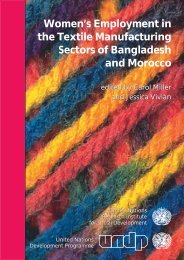The Politics of Gender and Reconstruction in Afghanistan
The Politics of Gender and Reconstruction in Afghanistan
The Politics of Gender and Reconstruction in Afghanistan
You also want an ePaper? Increase the reach of your titles
YUMPU automatically turns print PDFs into web optimized ePapers that Google loves.
EVOLVING INSTITUTIONAL FRAMEWORKS AND WOMEN’S RIGHTS: POTENTIALS AND LIMITATIONS<br />
MOWA started out with various limitations. Situated <strong>in</strong> a compound occupied by the PDPA-era Women’s<br />
Association, it <strong>in</strong>itially absorbed a large proportion <strong>of</strong> that body’s former, unspecialized staff, augmented by<br />
new political appo<strong>in</strong>tments. <strong>The</strong>re was an underst<strong>and</strong>able tension between the aim <strong>of</strong> provid<strong>in</strong>g jobs, however<br />
modestly paid, to women who had been denied opportunities under the Taliban, <strong>and</strong> the pr<strong>of</strong>essionalism<br />
required <strong>of</strong> a new civil service that was meant to be equipped with budgetary expertise <strong>and</strong> plann<strong>in</strong>g resources.<br />
<strong>The</strong> wholesale absorption <strong>of</strong> highly qualified Afghan civil servants <strong>in</strong>to aid agencies was noted, more generally,<br />
as part <strong>of</strong> a bra<strong>in</strong>-dra<strong>in</strong> that caused a critical shortage <strong>of</strong> English-speak<strong>in</strong>g staff able to engage with the <strong>in</strong>ternational<br />
community (Sedra <strong>and</strong> Middlebrook 2004). This was particularly acute among female cadres s<strong>in</strong>ce the<br />
orig<strong>in</strong>al pool <strong>of</strong> talent was even more restricted. <strong>The</strong> best qualified were attracted <strong>in</strong>to better-pay<strong>in</strong>g jobs <strong>in</strong><br />
<strong>in</strong>ternational organizations, from NGOs to the UN system. 29<br />
A related constra<strong>in</strong>t was that MOWA staff, even at the most senior levels, lacked familiarity with the strategies<br />
for gender advocacy <strong>and</strong> plann<strong>in</strong>g deployed <strong>in</strong> other countries. <strong>Gender</strong>-tra<strong>in</strong><strong>in</strong>g workshops conducted by<br />
UNIFEM aimed to <strong>in</strong>crease their exposure to these strategies <strong>and</strong> to provide the necessary technical knowhow.<br />
<strong>The</strong> workshops were also made available to gender focal po<strong>in</strong>ts that were established <strong>in</strong> l<strong>in</strong>e m<strong>in</strong>istries.<br />
Despite these focal po<strong>in</strong>ts, however, there appeared to be relatively limited mean<strong>in</strong>gful gender programm<strong>in</strong>g. 30<br />
Afghan staff <strong>in</strong> the UN system, familiar with both the requirements <strong>of</strong> the <strong>in</strong>ternational donor community <strong>and</strong><br />
the political pressures on the Afghan adm<strong>in</strong>istration, played a key role as <strong>in</strong>termediates between these different<br />
constituencies <strong>and</strong> <strong>in</strong> eas<strong>in</strong>g a steep learn<strong>in</strong>g curve.<br />
MOWA is attempt<strong>in</strong>g both to develop a national gender-ma<strong>in</strong>stream<strong>in</strong>g strategy <strong>and</strong> to implement donorfunded<br />
<strong>in</strong>itiatives that target women through local partnerships with NGOs. It co-operated with the GAG to<br />
formulate its Public Investment Programme (PIP), entitled “Advocacy <strong>and</strong> Support for the Integration <strong>of</strong> <strong>Gender</strong><br />
<strong>in</strong>to the National Development Budget”, with projects totall<strong>in</strong>g $892 million. This proposed PIP was passed <strong>and</strong><br />
approved by the M<strong>in</strong>istry <strong>of</strong> F<strong>in</strong>ance Budget Committee <strong>in</strong> January 2004. Several donors—<strong>in</strong>clud<strong>in</strong>g the UNDP,<br />
UNIFEM, the Japan International Cooperation Agency (JICA) <strong>and</strong> the Asian Development Bank—are<br />
provid<strong>in</strong>g support <strong>and</strong> technical assistance for the development <strong>of</strong> a gender-ma<strong>in</strong>stream<strong>in</strong>g framework.<br />
Part <strong>of</strong> MOWA’s budget was devoted to the establishment <strong>of</strong> women’s development centres (WDCs) <strong>in</strong> selected<br />
prov<strong>in</strong>ces to provide women with access to skills tra<strong>in</strong><strong>in</strong>g, health, literacy <strong>and</strong> civic education. This meant<br />
that MOWA needed to establish l<strong>in</strong>kages with NGOs <strong>and</strong> civil society partners at the local level. It is as yet<br />
too early to judge the effects <strong>of</strong> these <strong>in</strong>itiatives. It would be important to monitor the degree <strong>of</strong> synergy <strong>in</strong><br />
M<strong>in</strong>istry–NGO relations <strong>and</strong> to assess the extent to which women’s civil-society <strong>in</strong>itiatives are fostered (or<br />
otherwise) by the M<strong>in</strong>istry. In particular, it would be worth <strong>in</strong>vestigat<strong>in</strong>g the effects on the women’s NGO sector <strong>of</strong><br />
be<strong>in</strong>g redef<strong>in</strong>ed as subcontractors for government-sponsored programmes. <strong>The</strong>re are no systematic evaluations<br />
to date that could shed light on these issues.<br />
<strong>The</strong> establishment <strong>of</strong> a national mach<strong>in</strong>ery for the advancement <strong>of</strong> women is clearly <strong>in</strong> its early stages, with a<br />
strong donor focus on capacity build<strong>in</strong>g. It is, as yet, difficult to assess the outcome <strong>of</strong> these efforts. An area <strong>of</strong><br />
relative success <strong>in</strong> which the <strong>in</strong>ternational community, government bodies <strong>and</strong> women’s civil society organizations<br />
29 Alongside this bra<strong>in</strong> dra<strong>in</strong>, the reliance on a “second civil service” consist<strong>in</strong>g <strong>of</strong> well-paid consultants, advisors <strong>and</strong> employees <strong>of</strong> <strong>in</strong>ternational agencies<br />
<strong>and</strong> NGOs is presented as a major h<strong>in</strong>drance to state-build<strong>in</strong>g (World Bank 2004).<br />
30 <strong>The</strong>re were some notable exceptions. <strong>The</strong> M<strong>in</strong>istry <strong>of</strong> Foreign Affairs has created an Office <strong>of</strong> Human Rights, Health <strong>and</strong> Women’s Affairs to monitor<br />
women’s programmes. <strong>The</strong> M<strong>in</strong>istry <strong>of</strong> Commerce set up a department to help women establish their own bus<strong>in</strong>esses. <strong>The</strong> M<strong>in</strong>istry <strong>of</strong> Rehabilitation<br />
<strong>and</strong> Rural Development has also created a gender unit that <strong>in</strong>forms the programmes implemented by the M<strong>in</strong>istry. <strong>The</strong>re are plans to exp<strong>and</strong> gender units<br />
<strong>in</strong> 11 key m<strong>in</strong>istries.<br />
PAGE 17
















